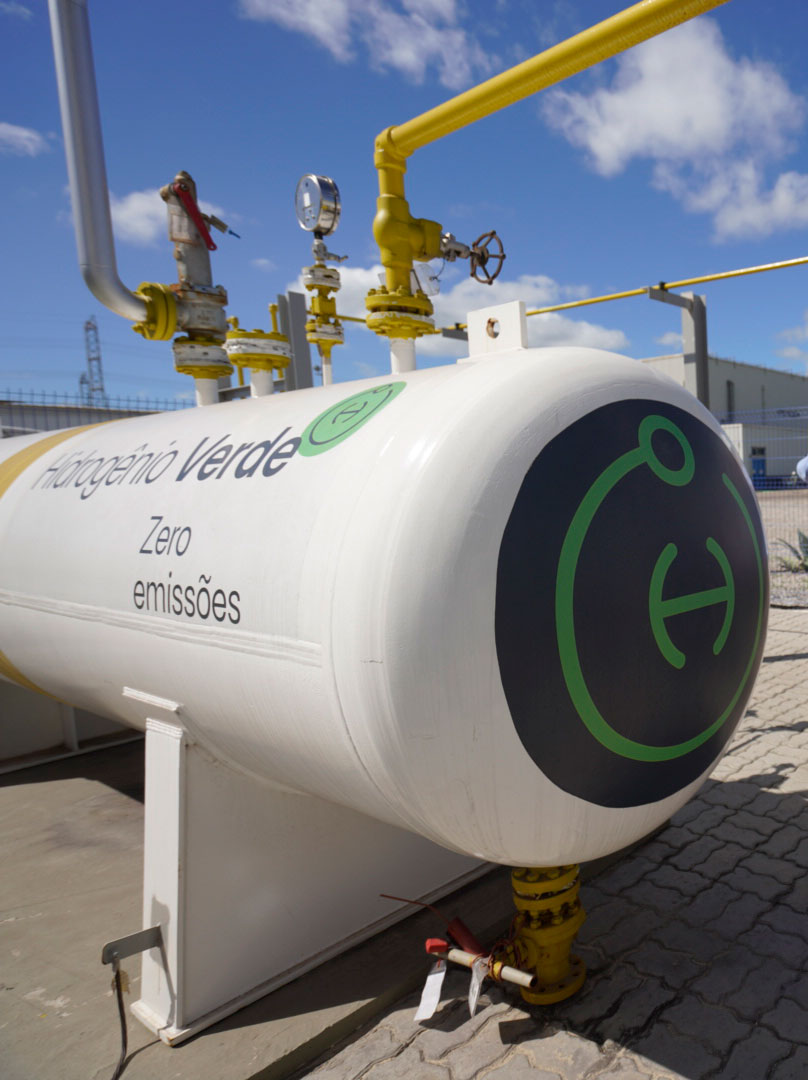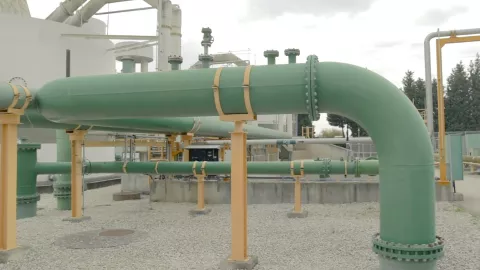What is renewable H2?
Currently, the existing hydrogen global market is estimated to be ~120- 180 b$. For comparison, renewable energy market has an estimated value of ~800-100 b$. In 2022, the H2 industry produced almost 95 Mt of hydrogen, most of which in dedicated local production sites for refining and ammonia processes. With ~83% of this hydrogen being produced from fossil fuels without carbon capture, the hydrogen industry was responsible for almost 2% of total global carbon emissions. However, with the need to decarbonize and the growing potential to use hydrogen in other applications, this scenario is likely to change.
Hydrogen has the capacity to support the decarbonization of various sectors, including transportation, industry, and power generation, as its combustion or use in fuel cells does not result in the emission of carbon dioxide (CO2). Even if some energy uses are technically challenging for direct hydrogen use, the production of hydrogen derivative products such as ammonia, methanol or sustainable aviation fuel may be an option.
As our world grapples with the urgent need to address climate change and transition to a more sustainable energy landscape, the race to be able to produce hydrogen at scale and with limited carbon footprint is on. While several technologies exist to produce hydrogen, relying on a variety of energy vectors, renewable hydrogen has been gaining traction as the best option, promising to revolutionize our energy systems, decarbonizing industries, support economic development and mitigate the environmental challenges we face.
But what is in fact renewable hydrogen? At its core, is hydrogen gas produced through a process called electrolysis, which uses renewable electricity, such as wind or solar power, to split water molecules into hydrogen and oxygen. Unlike traditional hydrogen production methods, which primarily rely on fossil fuels like natural gas, renewable hydrogen is generated with minimal carbon emissions. Even compared to the so-called blue hydrogen, produced from natural gas with carbon capture and storage (CSS), renewable hydrogen is expected to have lower environmental impacts. This makes it a clean and sustainable energy carrier with enormous potential to drive the transition to a carbonneutral world.
“Renewable hydrogen offers a pathway to a significantly reduce carbon emissions across multiple sectors.”

What are the opportunities?
The primary driver behind the implementation of renewable hydrogen is the urgent need to combat climate change. With rising global temperatures and increasing concerns about the environmental impact of fossil fuels, the transition to low-carbon energy sources has become imperative. Renewable hydrogen offers a pathway to a significantly reduce carbon emissions across multiple sectors, aligning with international climate goals outlines in agreements like the Paris Agreement.
But the adoption of renewable hydrogen brings about several benefits that justify the attention being given to it. One of the compelling reasons to adopt renewable hydrogen is the enhancement of energy independence and security. Renewable energy resources are better distributed than fossil fuels, enabling any country to produce some of their hydrogen needs and therefore reducing external dependency from fossil fuels. Additionally, by diversifying the countries they import from, nations can be strengthen their energy resilience and mitigate geopolitical risks associated with energy supply disruptions, in cases such as the war in Ukraine, which has shown us this so well.
The renewable hydrogen economy also represents a significant economic opportunity. It has the potential to create millions of jobs across the value chain, many of which in the countries where it is consumed, from renewable energy generation and hydrogen production to infrastructure development and research and development activities. Moreover, countries that position themselves as leaders in renewable hydrogen can benefit from export opportunities and economic growth.
With this in mind, over 52 countries have launched H2 strategies, and more are being prepared. The strategies aim to support the development of this new industry, establishing ambitious targets, proposing required regulation, implementing support mechanisms and detailing concrete steps across the value chain to enable its deployment (from the production of renewable electricity, manufacturing of equipment, deployment of projects, H2 transportation and storage and use). As expected, the strategies are based on the natural conditions that each country possesses and the current and future needs it may have.

Facing big challenges
But while the potential benefits of renewable hydrogen are vast, its widespread adoption is not without challenges. The first one being the lack of technological track record. Despite being a process with more than a century of history, electrolysis, the process used to produce renewable hydrogen, there is very little experience in developing large scale electrolysis production capacity. This is particularly true for most electrolyser manufacturers, which have not yet had the opportunity to produce their technologies at scale and for long periods of time. The implications of this are numerous, including lack of production capacity, low efficiency of the electrolyzers and uncertainty in their operation over time (lifetime, degradation, operational conditions).
Another challenge is the energy intensity aspect of renewable hydrogen production. With the current high prices of renewable electricity, and its lower competitiveness compared to the direct use of fossil fuels, this ends up being one of the key cost components for the production of renewable hydrogen. Also, the inexistence of a robust infrastructure for hydrogen storage, transportation, and distribution inhibits the development of large hydrogen production centers in areas with access to abundant renewable electricity but low hydrogen demand.
Finally, while significant progress is being made on establishing a complete regulatory framework and support mechanisms for the establishment of a hydrogen market, there is still several uncertainties on the application of many regulatory pieces.
Ultimately, all these challenges result in a much higher production cost for renewable hydrogen when compared to fossil fuels or hydrogen generated from fossil fuels. Reducing the cost through technological advancements (e.g. reduction of critical materials and efficiency improvements), economies of scale and significant increases in renewable energy capacity, by addressing land use concerns and grid integration issues, is essential for its competitiveness. In addition, there is a need to establish just regulatory and fiscal frameworks based on the polluter-pays principle to ensure a level playing field between renewable hydrogen and fossil fuel-based alternatives.
The path forward
The importance of renewable hydrogen in shaping a sustainable and carbon-neutral future cannot be overstated. It represents a powerful tool for addressing climate change, enhancing energy security, and fostering economic growth. While significant challenges exist, the concerted efforts of governments, industries, and the research community are driving innovation and progress.
As we move forward, it is crucial to prioritize investments in renewable hydrogen technology, as opposed to solutions based on fossil fuels, support policy frameworks that incentivize its adoption, and foster international collaboration to create a global renewable hydrogen economy. With determination and collective action, we can harness the potential of renewable hydrogen to build a cleaner, more resilient, and sustainable world for generations to come.
Key challenges
Electrolyzer manufacturing capacity
Most electrolyzer manufacturers have limited track-record, hindering the capability to deliver equipment at scale and on time, which brings uncertainty to the market in terms costs, performance and dates for delivery.
Technology immaturity
Most technologies have only been proven at a small-scale and lack the track-record to allow equipment manufacturers to provide warranties on the performance of the equipment during its operations (lifetime, efficiency degradation, operation conditions, among others).
Delays and unclear regulation
Despite positive advances in multiple regions on the regulatory framework concerning renewable hydrogen, several questions remain on their applicability, including the conditions under which hydrogen production may be eligible for certain supports or the concrete application of hydrogen consumption mandates.
High inflation and electricity prices
The recent energy and economic context has resulted in increased costs for equipment and the development of additional renewable electricity capacity, as well as higher power prices overall, which puts significant pressure on the cost of renewable hydrogen compared to the costs of fossil fuel based alternatives.
Global targets and initiatives
The H2 strategies currently launched would require more than 200 GW of electrolyzers to reach 2030 targets, with different regions following different approaches based on their natural conditions and expected needs for hydrogen.
The European Union has set ambitious targets for renewable hydrogen, aiming to become a global leader in this field. Projects like the European Clean Hydrogen Alliance and the Hydrogen Valleys Partnership are driving innovation and investment. At a EU level, there is a target to consume 20 Mt of renewable hydrogen by 2030, of which 10 Mt would be produced domestically and the rest imported from other regions. To foster this adoption, mandates for the uptake of renewable hydrogen and its derivatives have been set for the industrial and transport sectors. At a country level, Germany has launched the H2Global program (initial budget of 900 M€), aimed at importing ammonia, methanol and synthetic fuels. The Netherlands have earmarked 7.5 bn€ of funding for H2, of which 5.1 bn€ for onshore projects and 1.8 bn€ for offshore projects. The UK has several support mechanisms for H2, such as the £240m Net Zero Hydrogen Fund and the Hydrogen Production Business Model.
In the United States, the Department of Energy has launched the Hydrogen Energy Earthshot initiative, with the goal of reducing clean hydrogen production costs to $1 per kilogram within a decade. To support the uptake of clean hydrogen in the country, it has set a target to consume 10 Mt of clean hydrogen by 2030, it will support clean production by up to $3/kg through the US IRA (Inflation Reduction Act) and will distribute up to $7 billion to establish Regional Clean Hydrogen Hubs. Replying to the US IRA, Canada has announced it will enable a Hydrogen ITC (Investment Tax Credit) of 15 to 40% on H2 production equipment; expecting to allocate a budget of 5.6 bCAD in the next 5 years and 12.1 bCAD between 2028-2035; as well as establishing other decarbonization measures that also support H2 (RES ITC, CO2 price, clean fuel regulations).
Countries like Japan and South Korea are investing heavily in green hydrogen infrastructure, with a focus on importing hydrogen as a clean energy source. Japan’s Fukushima Hydrogen Energy Research Field is one such example. Japan has one of the oldest H2 strategies and recently reviewed it, increasing H2 supply from 2 Mt to 3 Mt by 2030 (expected review to 12 Mt by 2040), as well as establishing international partnerships to ensure imports of H2 and ammonia (Australia, Middle East and other countries in Asia).
The abundant renewable energy resources in the Middle East, Australia and South America have led to plans for large-scale renewable hydrogen production projects, with the intent to export hydrogen to international markets. In the case of the Middle East and Australia, this is a way of retaining their energy exports industries, while for South America it is viewed as a way of promoting economic development.
edpON magazine
Read more in our magazine
edpON magazine is a premium, global and up-to-date publication to highlight the drive, talent and energy within EDP. A cohesive element for the 13,000 employees around the world, it reinforces our culture and purpose. And, at the same time, an amplifier of the company's achievements among external audiences.






